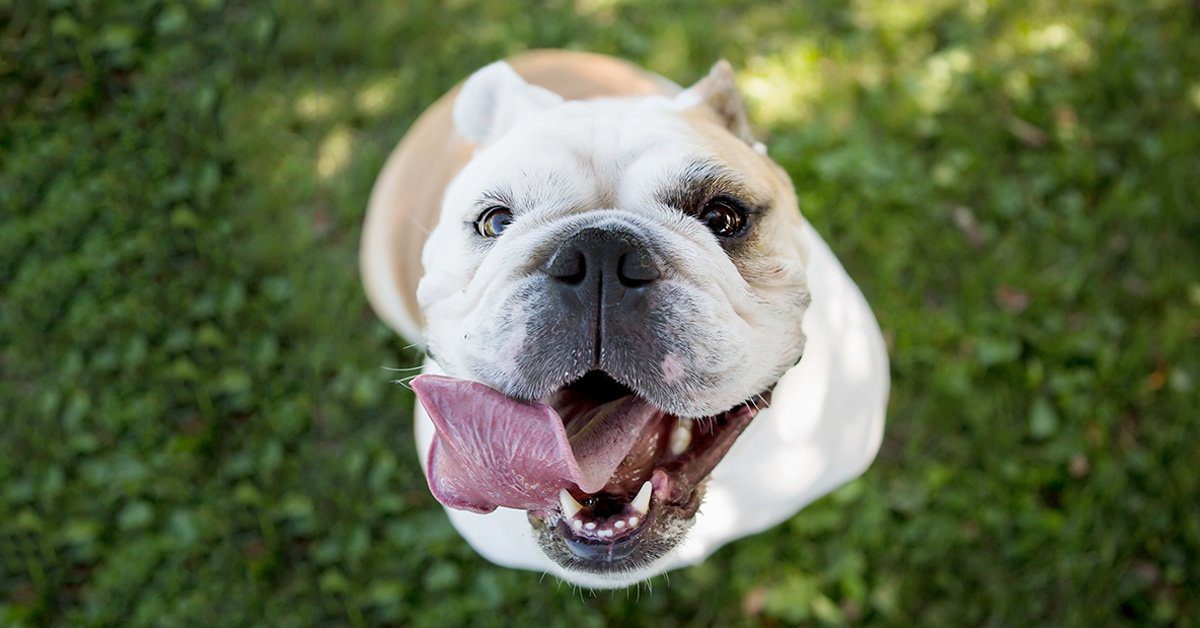Why is my dog panting?” you might wonder as you observe your furry friend. While panting is a normal behavior in happy, active dogs, particularly during warm weather or playtime, deep abdominal breathing, or panting in cool weather could indicate a medical issue.
But how do you know if your dog’s panting is normal or cause for concern? Understanding the difference between regular and excessive panting can help you figure out the right actions to take next.
Key Points
- Common reasons for dog panting include cooling off, excitement, playfulness, and stress.
- Abnormal panting can be caused by heat exhaustion, heatstroke, pain, heart or lung disorders, laryngeal paralysis, Cushing’s disease, and anemia.
- To determine if your dog’s panting is normal or a sign that something is wrong, you should take note of what your dog is doing, look for other signs/symptoms, and pay attention to changes in their panting sounds.
- When in doubt, call your vet.
Why do dogs pant?
Panting is a dog’s way of cooling themselves down. Unlike us humans, our canine companions lack an effective sweat gland system. While dogs have sweat glands in their ears and paws, these glands don’t contribute much to cooling them off. Instead, they use moderate to rapid open-mouth respiration to lower their body temperature and get oxygen into their bloodstream.
Some breeds, like French Bulldogs, Pugs, and Boxers, are brachycephalic – aka they have short and flat smushed faces that cause them to pant more due to their challenged upper airways.
The normal respiratory rate for resting or sleeping dogs ranges from 15 to 30 breaths per minute. Healthy dogs may experience heavy panting, but it should align with the air temperature or the level of exercise they’re engaged in. For example, if it’s hot out and your dog is panting, that’s normal, but if they’re panting out of the blue indoors, that’s likely a sign something’s wrong.
Common reasons for panting
1. To cool off
It’s normal for dogs to pant on a hot day or during exercise. Dogs that exercise rigorously (like running or playing fetch) will pant, and may even pause their run to lie down. This should be a sign to take a break and get your pup some water.
2. To express excitement
Sometimes, panting is simply a fun way for your dog to express excitement. When your furry friend encounters something thrilling, like meeting a new playmate or sniffing a treat, they might start panting. This type of panting, often accompanied by whining, tends to be rapid and shallow.
3. To demonstrate playfulness
Panting can also signify that your pup is eager to play and have fun. If this is the case, their body language will match with a wagging tail, relaxed face, and happy eyes. As the excitement dwindles, your dog’s panting will slow, transitioning from heavy breathing to mild pant with an open mouth.
Pro Tip: Illnesses won’t wait to happen. You shouldn’t wait to enroll in pet insurance. From common parasite infections to costly hereditary illnesses, pet insurance is worth it. It can cover crucial eligible treatment your pet may need for their unexpected accidents and illnesses. Find out how pet insurance works, what pet insurance covers, and choose a plan today.
4. To express stress
Many dogs pant in response to fear, anxiety, or stress from various triggers such as car rides, thunderstorms, vet visits, or just separation anxiety. Check for signs of distress, such as trembling, clinginess, flattened ears, drooling, hiding, or even limping. If their panting seems to be related, it’s best to remove your pup from the situation or comfort them the way only you can.
When is dog panting abnormal?
Dog panting becomes abnormal when it can’t cool your dog’s body temperature or doesn’t make sense situationally. Here are some signs that something is potentially wrong:
- Your dog’s respiratory rate is high (For example, your dog is taking 300 breaths a minute when normally your dog takes 20 complete breaths per minute)
- Your dog is panting but hasn’t been exercising
- Your dog’s panting sounds raspier or louder than normal
- Your dog is exerting more effort than normal while panting
- Your dog’s gums look lighter or darker than their normal color, or look blue
While most panting occurs to cool off your pup, it can also be prompted for a host of other reasons. It’s usually nothing to be concerned about, but there are a variety of health issues that could cause excessive panting that dog owners should know about.
Abnormal reasons for dog panting
1. Heat exhaustion
If your pup is panting all the time or faster than normal, they may have overheated. Their body temperature is too high, and they cannot regulate their body heat. This is also called heat exhaustion.
2. Heatstroke
While heat exhaustion and heatstroke are very similar, signs of heatstroke include excessive salivation, diarrhea, vomiting, depression, and dizziness. A rectal thermometer is usually used to determine if a dog is overheated. If it reads over 102.5 degrees, then your dog has heatstroke. Severe heatstroke is very serious and should be treated immediately.
3. Pain
Heavy panting can be a telltale sign that your dog is in pain. Watch out for other symptoms like enlarged pupils, decreased appetite, restlessness, anxiety, and licking or biting at the site of discomfort.
4. Heart or lung disorder
Heavy breathing in dogs could indicate that their heart isn’t pumping enough blood to their lungs. This, in turn, hinders oxygen transfer to their bloodstream and throughout their body. Dogs may increase their respiratory rate to compensate when their tissues lack oxygen. Other symptoms to watch include tiredness, coughing during breathing, and a purple tongue instead of pink. All these could signal inadequate oxygen levels.
5. Laryngeal paralysis
A dog’s larynx (or opening to the windpipe) contains cartilage flaps that open wide when your dog breathes and closes when they swallow. Laryngeal paralysis occurs when one or both of their flaps fail to open normally, making their breathing more difficult.
This is most common in middle-aged and older dogs, as their larynx gradually loses its normal function. Labradors and Golden Retrievers can also be more prone to this condition.
6. Cushing’s Disease
Cushing’s disease occurs when a dog’s adrenal glands produce too much cortisol. This can cause your dog to pant more than usual. They may also be hungrier, thirstier, excessively tired, and peeing more than usual.
7. Anemia
Anemia in dogs occurs when their red blood cells decrease. Red blood cells transport oxygen to their body’s tissues so that fewer blood cells can lead to oxygen deprivation, heavy breathing, and excessive panting.
How can you tell the difference between normal dog panting and excessive dog panting?
To determine if your pup’s panting is normal or a sign that something is wrong, you should:
- Take note of what your dog is doing. Is your dog exercising? Are they stressed, excited, or hot?
- Look for other signs/symptoms. Is your pet healthy? Is your dog lethargic or not eating well? Have they been coughing?
- Pay attention to changes in their panting sounds: Any changes to the sound of your dog’s panting shouldn’t be ignored.
The bottom line on dog panting
In conclusion, panting is a normal behavior in dogs, especially when they need to cool down or express excitement. However, heavy panting may signify a life-threatening health condition that requires veterinary attention.
In that case, don’t hesitate to take them to the vet for a proper diagnosis and treatment plan. Your vet can observe your furry friend, assess their heart and respiratory rates, and measure the oxygen saturation in their blood. Remember, it’s always better to play it safe!
If excessive panting signals an unexpected illness, you’ll want your pup to receive top-notch veterinary care. Pumpkin’s dog insurance plans can help cover vet bills, allowing you to focus more on care and less on cost.
FAQs
Why is my dog panting so fast?
Fast panting while resting could indicate ahealth issue such as heat exhaustion, heart or lung problems, pain, anxiety, or Cushing’s disease. It’s best to consult your veterinarian to determine the cause and receive proper treatment.
How do I stop my dog from panting?
It is not recommended to completely stop your dog from panting as it is a natural behavior and necessary for regulating their body temperature and getting oxygen into their bloodstream. However, if your dog is panting excessively or abnormally, you should bring your dog to the vet’s office.
Why is my dog panting for no reason?
Dogs may pant for various reasons – to ward off hot weather, cool down from exercise, and express excitement or anxiety. However, if your dog is panting excessively or for no apparent reason, it could be a sign of a medical condition. It’s best to consult a veterinarian to determine the cause of your dog’s panting.
What are the signs of heart failure in dogs?
Signs of heart failure in dogs include coughing, difficulty breathing, lethargy, decreased appetite, weight loss, and abdominal distension. It’s important to seek veterinary care immediately if you suspect your dog may be experiencing heart failure.




